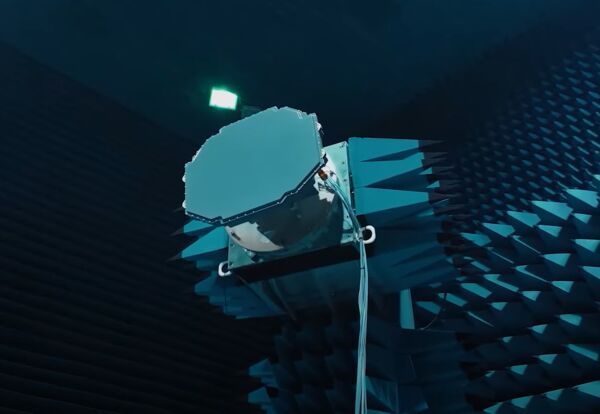- About
- Intara
- Capabilities
- Advisory
- Resources
- News
- Store
New Aselsan radar makes debut flight on F-16 aircraft
27 March 2024
by Olivia Savage & Cem Devrim Yaylali & Raghuraman C S


A screenshot from an Aselsan video showing its new AESA radar in an anechoic chamber prior to flight trials aboard an F-16. (Aselsan)
Aselsan's new active electronically scanned array (AESA) Nose Radar has completed its maiden flight onboard the Turkish Air Force's (TuAF's) Lockheed Martin F-16 Block-30 fighter jet.
According to Aselsan on 26 March, the indigenously developed radar is designed to support both air-to-air and air-to-ground missions and offers capabilities such as multitarget detection and tracking, beyond-visual-range missile guidance, high-resolution imaging, and electronic warfare functionalities.
Commonly referred to as Murad, the Nose Radar is a key component of the Özgür programme, dedicated to modernising the TuAF's F-16 Block-30 fleet. The initiative involves integrating new indigenous software and hardware on the aircraft, including for the mission control computer, and replacing elements of the avionics and cockpit displays.
After successful integration of the Nose Radar on the F-16 Block-30s, the aircraft will become a 4.5-generation platform, according to the President of Defence Industry Agency (SSB), Haluk Görgün. İsmail Demir, then president of SSB, noted in November 2022 during an unveiling of the radar that its capabilities were “equivalent to the most advanced radars in the world”.
Poland acquires AR-1500 airborne radio system
20 May 2024
by Nidhin Narayanan


The TruNet AR-1500 airborne communications system will be installed in the Polish Air Force's C-130H Hercules fleet. The system's dimensions are 250 (L) × 127 (W) × 142 mm (H). (Janes/Kelvin Wong)
Collins Aerospace has been awarded a contract to supply its TruNet AR-1500 networked communications airborne radio system to the Polish Air Force.
According to an announcement by the company on 14 May, the radios will be installed on the force's Lockheed Martin C-130 Hercules fleet.
The AR-1500 is a single-channel export version of the ARC-210 radio software-defined radio (SDR) receiver-transmitter, offering country-unique capabilities and legacy waveforms while conforming to the latest SDR tenets and architectures, the company said.
Weighing 5.5 kg, the system is fully interoperable with earlier airborne V/UHF radio variants from Collins Aerospace and other airborne V/UHF radio systems.
The system supports a variety of waveforms, including Have-Quick I/II, Second Generation Anti-Jam Tactical UHF Radio for NATO (SATURN), and Talon I/II. It also features embedded AES-256 encryption protocols and can host indigenously developed crypto.
For more information on the TruNet AR-1500 radio, please seeTruNet AR series networking airborne radio .
Silvus Technologies unveils MANET end-user interface
20 May 2024
by Carlo Munoz


The DOCK StreamCaster SC4210P is one of three DOCK StreamCaster variants deing developed by Silvus Technologies. (Silvus Technologies )
Networked radio manufacturer Silvus Technologies has unveiled a new family of end-user interface systems for its StreamCaster tactical radios, which will pair the company's mobile ad hoc networking (MANET) radio platforms with advanced edge computing capabilities and artificial intelligence (AI)-enabled systems and applications.
A joint venture between Silvus and Washington-based wireless networking company Kägwerks, programme officials have developed three variants of the Dismounted Operator's Combat Kit (DOCK) StreamCaster end-user interface, each mirroring the capabilities of the StreamCaster MANET radio embedded into a specific variant.
The DOCK SC4240P variant, whose 4 W output puts it as the most powerful of the three DOCK systems, “has the same guts as our 4240 StreamCaster radio”, while the two other DOCK variants – the DOCK SL4210P and Ultra 4210P – are all internally modelled after the 1 W 4210 StreamCaster MANET radio, said Jimi Henderson, vice-president of sales at Silvus.
The transmission power differentials are “the main tradeoffs” between the variants, Henderson told Janes
Azerbaijani artillery using Israeli ELM-2084 as counter-fire radar
17 May 2024
by Jeremy Binnie


A still from a video shows an ELM-2084 radar being deployed during an Azerbaijani artillery exercise. (Azerbaijan Ministry of Defence)
The Azerbaijani Ministry of Defence (MoD) has confirmed its land forces are using a smaller version of the Israeli-made ELM-2084 multimission radar to support artillery units.
An Israel Aerospace Industries (IAI) Elta ELM-2084 was seen clearly in a video released by the MoD on 16 May to show an artillery exercise involving 2S19 Msta-S self-propelled howitzers (SPHs) and 2A36 Giatsint-B towed guns.
Azerbaijan was already known to have an ELM-2084 as one was seen in a video the MoD released in April 2020 showing the radar with the IAI Barak-8 air-defence system deployed north of Baku.
A smaller ELM-2084 was probably glimpsed in television coverage of a visit that President Ilham Aliyev made to a new base in Beylagan in February 2019. A statement released by the president's office said he was shown a “universal radar complex” that is used to support artillery units and monitor enemy fire.
Aselsan's new active electronically scanned array (AESA) Nose Radar has completed its maiden flight ...
Latest Podcasts
The value of OSINT for intelligence sharing
In this episode Harry Kemsley and Sean Corbett are joined by Phil Ritcheson Ph.D. to discuss why intelligence sharing is now more important than ever. They discuss the growing need for allied and partnership and how by using open sources facilit...
Listen nowJanes Case Studies
Using Janes Intara to build a common intelligence picture: Russian build up on the Ukrainian border
View Case StudyNews Categories
 Air Details
Air Details